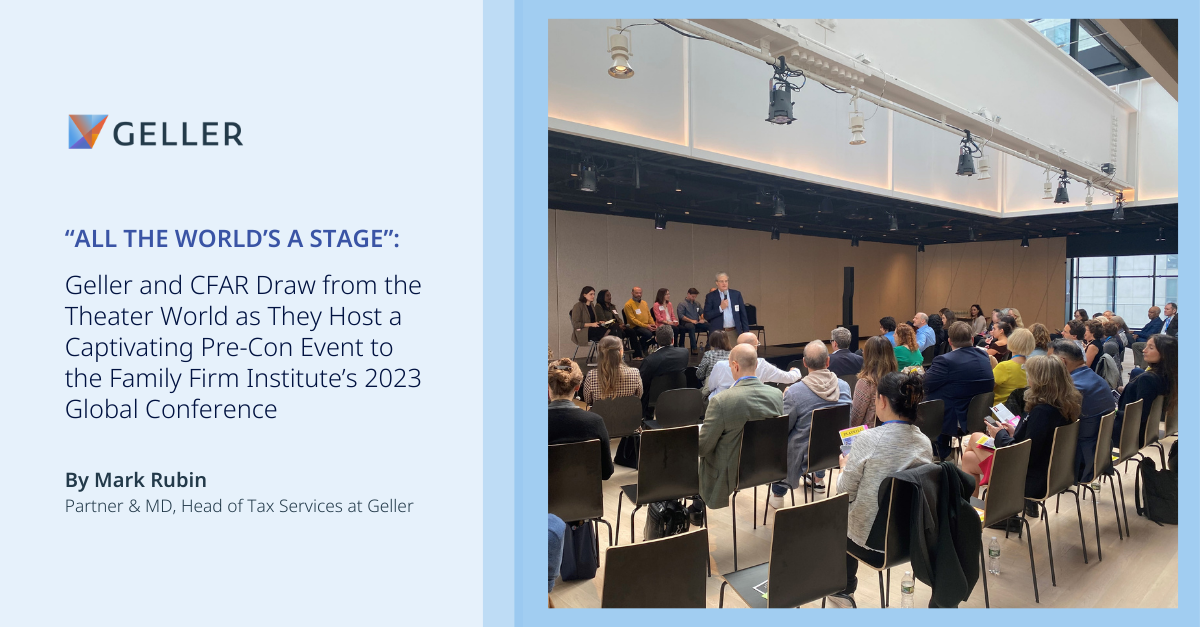- The Discovery Phase: Working with Clients
- Are Strong Personalities Fixable?: Navigating Conflict with Tact
- Wearing Two Hats: A Requisite for Success
- Respecting Our Clients’ Legacy and Approaching Issues with That in Mind
- Staying Nimble: When You Think You’re Doing a Play Reading, but it Turns Out to be Improv
- Key Themes in Small-Group Breakout Sessions
- Conclusion
- Panelist Bios
On October 25, Geller and CFAR hosted a pre-conference event at The Shed, one of New York City’s newest cultural venues, located in Hudson Yards. The audience of 70 listened to a panel discussion that explored the link between the work of theater professionals and family enterprise advisors, as well as the skills required for their day-to-day work.
I was fortunate to collaborate with Eliza Orleans and Caleb White, who not only are both talented advisors from CFAR, but also both have theater production in their past. Eliza, Caleb, and I hypothesized that there are important parallels between the issues and challenges that theater professionals and advisors to family firms face. What emerged was a fruitful discussion and exchange of ideas about leadership, collaboration, connection, patience, and maintaining a sense of humor. In addition to Eliza, Caleb and myself, our panelists included the following theater professionals.
- Paul Coffey, actor, musician, and Fiasco Company Member
- Tiffani Gavin, Director of the Eugene O’Neill Theater Center
- Joey Parnes, an eight-time Tony Award-winning producer of plays and musicals
- Christine Scarfuto, a dramaturg, producer, and Hunter College professor with deep experience in new play development
Pictured below, left to right: Mark Rubin, Eliza Orleans, Caleb White, Paul Coffey, Tiffani Gavin, Joey Parnes, Christine Scarfuto

The Discovery Phase: Working with Clients
Whether you’re working on a script or advising and supporting clients, the discovery phase is an essential part of the process. Advisors, like theater professionals, engage participants in a process that explores the goals and attitudes each individual has towards the project or issue at hand. A core component of the discovery process is gaining an understanding of to what extent the participants “believe” in the project and the manner in which each defines success.
Do we believe in the work? Are we going to produce work the client believes in?
Joey Parnes, eight-time Tony Award-winning producer and manager, made this point: “In terms of discovery… The play has to have heart. Do I care about the people that I’m being introduced to (the characters in the play)? Does the play evoke an emotional response? All the rest is fixable. The development process is fast and rigorous. We have to meet and collaborate with all people as part of the creative and discovery process.”
Tiffani Gavin, Director of the Eugene O’Neill Theater Center, expanded on this theme.
“We have an army of literary professionals, artistic directors, theater enthusiasts. We’re not looking at whether the script is good or bad, or whether we like it as much as whether the script is saying something new. Our nonprofit theater company seeks to develop new works and new voices.”
She continued, “Is (the script) saying something new? Is the voice interesting? Does it bring something new to the table, adding to the artistic conversation? Does it push boundaries?”
In Gavin’s particular case at the Eugene O’Neill Theater Center, approximately 1,400 scripts are submitted for consideration each year. Of these, only eight scripts are chosen.
The panel also explored how the development of a theater piece relates to an advisor’s work with families.
Advisors collaborate within teams, across teams and specialties, and across organizations. When working with clients—each client is unique, and each production is unique—we must ask ourselves similar questions:
- “How can we really understand the motivations of the family?”
- “What do they want us to bring to life?”
- “How can we support their desires?”
- “Can we think out of the box to help make this project a success?”
The advisor panelists, led by Eliza Orleans, observed that “When presenting ourselves to clients, we have to care about and believe in the work we’re asked to do by each individual and try to build a meaningful consensus that can be supported by the entire system. She reiterated what Joey mentioned, “the rest is fixable.”
What about working with strong personalities? Is that fixable?
Are Strong Personalities Fixable?: Navigating Conflict with Tact
Navigating conflict is an inevitable part of the process when you’re working with strong personalities. And the process of meeting complex client objectives—much like producing a Broadway musical, we learned—is not linear and contains a number of moving parts.
“When you talk about collaboration, it happens in rehearsal with one group, in an ad agency with another group of people, then in another space with theater professionals,” said Joey Parnes. “The depth of collaboration needs to shift based on who the contributing parties are.”
For example, in a Broadway production meeting with co-producers, those who have invested in the musical, a democracy is not necessarily appropriate. But for Paul Coffey, who is part of a nine-person theater company, all of whom may wear a number of hats in a single production, crowd-sourcing ideas is sometimes the best way to find an elegant solution to a problem at hand. “Say we’re faced with a problem. In Into the Woods, maybe we need to figure out how the wolf is going to eat Little Red on stage, effectively and in front of a live audience. At that point, opening up the floor to everyone—stagehands and managers, actors, lighting technicians—can help us get to the most effective solution the quickest.”
According to Parnes, the creative process requires collaboration; however, the right people need to be driving the bus. Naturally, this can be challenging when dealing with strong personalities. “People who are very passionate, volatile, and emotional can really believe what they think is right. Sometimes they’re right, sometimes they’re verywrong.”
For advisors, it’s no different. The creative process can look entirely different depending on who is in the room, and collaboration takes place in many forms. This takes place with clients, subject matter experts, the core team, and with external partners. What’s more, our clients have strong opinions and objectives we’re tasked with meeting—and they have every right to express those opinions and expect us to meet the objectives at hand with a well-designed approach. Here’s what’s true across both disciplines; the solution is always tailored to the exact problem we’re trying to solve, and the people involved in solving it, which can vary over the course of a project. Mediating and mitigating conflict is very much a cornerstone for both disciplines.
Even when it means giving tough feedback.
A spirited discussion followed related to how to share essential feedback with those who have strong opinions or personalities.
Christine Scarfuto, in both her work with helping playwrights develop their plays as a dramaturg and as an educator who fosters new writers’ development offers this advice: “The most important thing for you to do is to say the thing you’re afraid to say. Often, you’ll have notes where they’ll have to rewrite the whole play.”
As frightening as this is, it’s the truth and often the best route. “The problem usually gets bigger otherwise.”
Scarfuto recommends the Liz Lerman method of feedback.
Liz Lerman’s Critical Response Process is a four-step method for giving and getting feedback on work in progress, designed to not only provide the truth, but to do it in a way that leaves the creator eager and motivated to get back to work.
The four-step process is as follows:
Step 1. Statements of Meaning: Responders state what was meaningful, evocative, interesting, exciting, and/or striking in the work they have just witnessed.
Step 2. Artist as Questioner: The artist asks questions about the work. In answering, responders stay on topic with the question and may express opinions in direct response to the artist’s questions.
Step 3. Neutral Questions: Responders ask neutral questions about the work, and the artist responds. Questions are neutral when they do not have an opinion couched in them.
Step 4. Opinion Time: Responders state opinions, given permission from the artist; the artist has the option to say no.
Scarfuto expands on this. “The final step I do is not an official part of the Liz Lerman process.
It’s sharing Glimmers.
Glimmers are moments of language or imagery in a play you found beautiful. It’s an opportunity to appreciate the space in which vulnerable work is shared. It’s important that we ask questions out of true curiosity, not judgment.”
It was apparent that much of what Christine was offering resonated with the audience.
In generational shifts with family enterprise clients, advisors are often faced with providing meaningful (and often needed) feedback to leaders. Often this comes after attempting to coach family members who are willing to engage other family members with whom there may be a challenging dynamic. Either way, following this structured approach to providing feedback is worth considering.
Another perspective that was explored by the panel observed that employing a feedback loop that borrows from Lerman’s directive doesn’t only support collaboration—and demands that all members of the team be in tune with the work being done—it also creates a culture of continuous improvement, focused on the betterment of the individual and the work as a whole.
Wearing Two Hats: A Requisite for Success
In some of our panelists’ work, they described wearing two hats as being an essential skill involved in the creative process—yet another vital equivalent shared with the work of advisors to family enterprises.
Paul Coffey, as a professional who might be directing a play or producing the music and acting in the play at the same time, had this to say about wearing two hats. “It’s about wearing different hats and knowing what hat you’re wearing at a specific time. Personally, I can’t be creating and critiquing something at the same time. It’s hard for me to go with a creative flow and stop and adjust in real-time.”
From time to time, both theater professionals and advisors need to take a step back and see the bigger picture without getting too bogged down in the details.
The similarities are there for advisors as well.
“As advisors, we have to be both ‘in it’ and ‘out of it,’” said Eliza Orleans. “We’re in it with clients and problem-solving and building relationships. The challenge is we have also been hired as outsiders. We need to keep that critical distance so we can be helpful in that respect.”
Wearing two hats is something that Coffey has trained to do over the course of his professional career, producing a show with his company depends on the team’s very ability to do so. As advisors, shifting between modes with such grace may prove to be more difficult, particularly amidst high-stakes conversations and challenges with clients.
Parnes shared a helpful tactic for doing so.
Voice which hat you’re wearing to deliver specific feedback. Saying aloud the transition in thought process or perspective from which you’re addressing a problem can allow others to process the information you’re sharing more openly, as they’ve made the transition in thinking with you. For example, “If I’m wearing my owner hat, I’m thinking X, but if I put on my family hat, I’d propose that Y.”
But what happens when your feedback is rejected?
Parnes recommends that professionals “align first; then once the other party is open to receiving information, you can say, ‘But you know there’s one question I want to ask you.’ At that point, I can ask honest questions.”
Respecting Our Clients’ Legacy and Approaching Issues with That in Mind
The panel also touched on legacy. “We’re all chasing immortality.”
Passionate theater professionals have a legacy – they want to be remembered for their contributions to the world – Advisors to family enterprises similarly want to help their clients perpetuate and define theirs.
Clients want their advisors to think of this in concrete terms that are congruent with their legacy, be that wealth preservation, the value they pass on to their progeny, their philanthropic efforts, the organizations they lead or support, and of course their children and their future. Understanding clients on this deeper level allows us to problem solve from this lens.
As advisors, our ability to tend to this larger issue of immortality and legacy is at the crux of most of our client relationships. Showing up for our clients in this way is paramount to a successful, long-term working rapport.
Staying Nimble: When You Think You’re Doing a Play Reading, but it Turns Out to be Improv
Many times, advisors enter meetings with a script (an agenda, a plan, a deck), and when we get there, it turns out the client wants to do improv. So, how does a skilled advisor step into a room and a role and improvise on the spot? How can we align with our clients so that everyone is singing from the same sheet of music?
Advisors are expected to remain nimble.
Gavin says, “You can’t control what is coming externally. I just have to be prepared for whatever comes my way.” He added that every performance is different – there are various levels of energy, different ways in which lines are delivered, as well as the impact that the audience has on the actors.
Gavin recommends using ‘Yes and,’ the classic improv technique as an effective way to respond to an unexpected request or note. It’s a response that leaves the other person more open to what is being offered. This differs from “Yes, but,” which can imbue a sense that someone has said or done something wrong. Further, knowing ahead of time what the critical mission is—and being aligned on that with the other members of your team in the room—can help redirect or reshape the conversation in a more operative way. “Invite them into conversation and be prepared with what your North star is,” said Gavin.
Scarfuto explains it like this, “When I’m in a creative mindset, I try to not say no. I just roll with it and go along on the ride. I’ll ask questions, and often suggest that we try something new (the thing that’s being proposed). If it doesn’t turn out, okay, it didn’t work. Now we can try something else. In my line of work, it’s an opportunity for brainstorming.”
In our line of work, at all times, it’s the clients (like the audience) whose lives we are looking to serve and impact positively.
It’s important that we remain nimble, so we’re prepared for the unexpected twists and turns clients take along the way. This isn’t a democracy; ultimately, it’s our clients and stakeholders livelihoods that we’re responsible for supporting in very specific capacities. It’s up to us to take it in the right direction, and to do so in a way that they agree with. Ultimately—and rightly so—they have the final say.
Key Themes in Small-Group Breakout Sessions
In addition to the panelist discussion, the panelists led four, smaller breakout groups to further explore individuals’ work focus and possible adaptation of the panel discussion topics. In one group, the question was raised whether or not a consultant is wise to share their own values when sharing feedback. While views varied on the specifics, it was generally agreed that integrity was paramount which aligned with the Lerman method of feedback.
Another group reported a discussion that emerged related to the notion of keeping the glimmer alive with clients and continue to bring that glimmer to the work the same way playwrights do. We can look for the moments that matter and connect with our clients and the work in that manner, beyond the technical: the areas where clients share themselves, their goals, and their ambitions.
“It starts with a level of respect, an assumption you’re all working toward the same goal,” said Tiffani Gavin. “I know that I need to take in things I’m hearing; when I get feedback, remember that part of my job is being a good steward, being the person who keeps everything going in the right direction.” This is why feedback is so important. It’s about understanding “what’s working, what’s not working, and how we can keep moving in the same direction together. Pursuing this requires authenticity. Achieving this produces trust.”
Conclusion
It turns out our hypothesis was indeed correct.
When it comes to the link between the work of theater professionals and family enterprise advisors, there’s a certain degree of overlap that’s unavoidable. Whether you’re working on a script or advising and supporting clients, there’s an art and science to the customaries of the profession. It’s an essential part of the process. Advisors, like theater professionals, use similar vehicles; discovery, conflict management, improv, wearing two hats, and curating a strong legacy. These details help theater professionals and family enterprise advisors accomplish the work at hand.
Panelist Bios
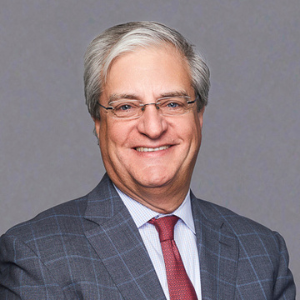
Mark Rubin serves as Managing Director, Head of Tax Services at Geller Tax LLC. He has over 30 years of experience advising multigenerational families, supporting and strategizing the development of all aspects of a family’s wealth, including succession planning and next-generation leadership development. Mark has provided transaction support, capital raising assistance, and governance planning to individuals and multigenerational families, including some of New York’s legacy real estate families.
Mark served as a member of the FFI Board and has Chaired two FFI global conferences. He also led the formation of and subsequently Chaired the New York State Society of CPAs Family Office Committee.

Eliza Orleans is a Manager at CFAR Consulting and Coaching, where she works to help members of family and owner-led businesses articulate, align, and act upon their goals. She draws on eight years of experience in nonprofit management, with expertise in strategy, meeting design and facilitation, operations, and governance. She also authored a case study for use at the Yale School of Management on leadership transition in the arts and cultural sector.
Eliza’s recent speaking engagements include Family Business Magazine’s Transitions Conference, the Estate Planning Council of New York City, and Temple University. She also authored a case study for use at the Yale School of Management on leadership transition in the arts and cultural sector.
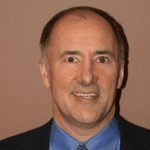
Caleb White is a Principal at CFAR Consulting and Coaching, where he specializes in the complex strategic and operational issues facing today’s organizations. He draws on his experience as a high-impact leader in both privately held and large public companies, at different stages of development and across multiple industries. This includes leading his sixth-generation family business, Ensign-Bickford Industries, Inc. Caleb brings both personal and professional insight to leadership and governance dilemmas facing clients.
As a member of CFAR’s Owner-Led Business practice, Caleb’s work is driven by an ability to create strategic value: identifying investment/acquisition opportunities, strong P&L acumen, and dedication to building a culture of operational excellence. From his experience in his family’s business, he is also particularly attuned to high stakes shareholder issues and complex multi-generational family business dynamics.
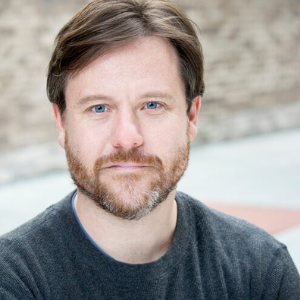
Paul L. Coffey, actor, musician, and Fiasco Company Member. For Fiasco: Pisano/Philario//Guiderius/Caius Lucius, Cymbeline, Malvolio, Twelfth Night, Angelo/Elbow, Measure for Measure, Speed/Thurio, The Two Gentlemen of Verona, Mysterious Man, Into the Woods, Thomas Diafoirus/Beralde/Bonnefoi, The Imaginary Invalid, Joe Josephson, Merrily We Roll Along. Off-Broadway: The Taming of the Shrew. Regional: The Old Globe, McCarter Theater, Folger Theater, Actors Theatre of Louisville, Pig Iron Theatre Co., Berkshire Theatre Group, Vineyard Playhouse, Company of Fools, The Theater at Monmouth, Peterborough Players. TV/Film: Blue Bloods, Late Night, The Jew of Malta. Paul is husband to frequent Fiasco collaborator Liz Hayes and father to Sean Frank Coffey, who made his Broadway debut at six months old in The Ferryman.
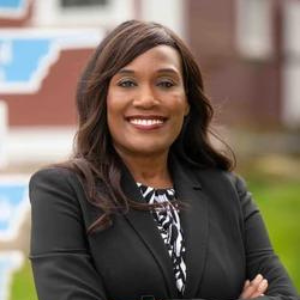
Tiffani Gavin, Executive Director of the Eugene O’Neill Theater Center. Tiffani brings more than 25 years of experience in theater administration and producing to her position as Executive Director of the Eugene O’Neill Theater Center. After beginning her career in general management at The Public Theater in NY and as a company manager at Blue Man Group, she went on to hold leadership positions in both nonprofit and commercial theater organizations, including Clear Channel Entertainment and the American Repertory Theater. She’s been the Manager of the Marquis Theatre on Broadway and has managed productions such as the National Tour of The Phantom of the Opera. As an Executive Producer for Clear Channel Entertainment and later as the General Manager/VP of Production at Martian Entertainment, she commissioned and developed new work by emerging artists across the U.S. and internationally.

Joey Parnes, is an eight-time Tony Award-winning producer and manager of plays and musicals for Broadway and the road. Past Broadway credits include Gary: A Sequel to Titus Andronicus, Hillary and Clinton, King Lear, and To Kill a Mockingbird. His company, Joey Parnes Productions, also provides executive producer and general management services for a wide range of theatrical ventures, including non-profit theater consulting and working with nonprofits on Broadway transfers.
Past Broadway credits include: Gary: A Sequel to Titus Andronicus, Hillary and Clinton, King Lear, To Kill a Mockingbird, The Waverly Gallery, Carousel, The Iceman Cometh, Three Tall Women, 1984, Meteor Shower, A Doll’s House, Part 2, Hello, Dolly! (Tony Award, 2017), The Glass Menagerie, The Front Page, The Humans (Tony Award, 2016), Bright Star, Shuffle Along, Arthur Miller’s The Crucible, Blackbird, Arthur Miller’s A View From the Bridge (Tony Award, 2016), A Gentleman’s Guide to Love & Murder (Tony Award), Skylight (Tony Award, 2015), Fish in the Dark, This Is Our Youth, A Delicate Balance, A Raisin in the Sun (Tony Award, 2014), Betrayal, Vanya and Sonia and Masha and Spike (Tony Award), End of the Rainbow, The Merchant of Venice, Bloody Bloody Andrew Jackson, Equus, HAIR (Tony Award, 2010), Passing Strange, Butley, Who’s Afraid of Virginia Woolf?, The Goat, or Who is Sylvia?, Copenhagen, The Tempest, Bring in ‘da Noise, Bring in ‘da Funk, Grand Hotel, Passion, Legs Diamond, Rags, The Floating Light Bulb, Camelot, and the original production of Dreamgirls (starting as the Assistant Company Manager).
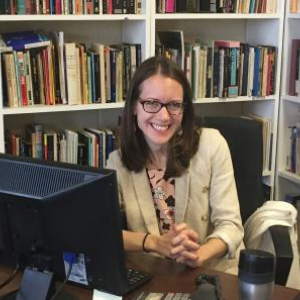
Christine Scarfuto is a dramaturg, producer, and educator with over a decade of experience in new play development. For the past four years, she has served as the Director of the Rita and Burton Goldberg MFA Playwriting Program at Hunter College. Prior to that, she was the Literary Manager of Long Wharf Theatre, where she developed work by Steve Martin, Adam Gopnik, David Shire, Sam Hunter, Clare Barron, Whitney White, Jen Silverman, and Christopher Chen, among others. She was the Producer of the Hudson Valley Shakespeare Festival’s developmental theater lab, and has worked as a dramaturg with Clubbed Thumb, Kennedy Center, Lark Play Development Center, McCarter Theater, Hudson Valley Shakespeare Festival, New Dramatists, Playwrights Center, Playwrights Realm, Primary Stages, Second Stage Theater, Signature Theatre, Theatre for a New Audience, and Williamstown Theatre Festival.
Christine has taught at Fordham University, Rutgers University, and the University of Iowa. She was educated entirely in public schools including the University of Iowa, where she received her MFA in Dramaturgy.
